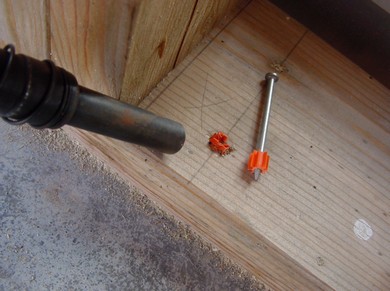
Finishing basements and turning them into living spaces is something a lot of homeowners are interested in. Regardless of the design features you’re building into your guest room, home office or playroom, there’s one tool that can help a lot. Generically called powder-actuated tools (PATs), all types use a charge of gunpowder to propel hardened metal fasteners right into concrete, brick, block and even steel, all without the need to predrill holes. It’s the ideal option for anchoring all those new walls to the floor. And while this might sound dangerous, there’s no need to be afraid. PATs available at the retail level are safe when used correctly, and it’s easy to use them right. They’re also highly effective, especially when it comes to basement work.
The least expensive option for getting into the PAT game is with one of the single-shot, hammer-activated models. These cost less than $50 and are available at hardware stores everywhere. Loading a tool like this is something like loading a single-shot .22 rifle. Insert a special hardened nail into the muzzle, opening the chamber, insert an explosive cartridge, then close the chamber before placing the muzzle of the tool against the surface to be fastened. You’re now ready to fire with a sharp hammer blow to the firing pin on the top of the handle. Firing the tool again involves manually unloading the spent cartridge case, inserting another pin into the tool, loading a new cartridge, then striking with the hammer once more. Even with this multi-step process, simple, single-shot PATs are still much faster than any other option for anchoring walls to concrete basement floors.
PATs are safe when used correctly, but they do demand caution. Wear safety glasses or a face shield, along with hearing protection during use. Even though PATs can’t fire unless they’re pressed against a hard surface, never point them at anyone. Keep bystanders at least 20 feet away during use. When cartridges occasionally fail to fire, continue to hold the tool in place for 15 to 30 seconds, in case it goes off in a delayed way. After that, unload the defective cartridge with care while continuing to point the tool as if you expect it to fire. It probably won’t, but be careful just the same.  One of the most common uses for powder-actuated tools is for fastening the bottom of a wood or steel-framed wall to a concrete floor. And they’ll do an excellent job, though there is a trick.
One of the most common uses for powder-actuated tools is for fastening the bottom of a wood or steel-framed wall to a concrete floor. And they’ll do an excellent job, though there is a trick.
Instead of just relying on the fasteners alone, there’s reason to go beyond the basics when it comes to anchoring basement partition walls. Although any kind of metal fastener that depends on friction to hold within masonry can do a good job long term, there’s also a possibility they can work loose in time. That’s why you should consider using construction adhesive as well as fasteners along the bottom of wall plates. Not only does this guarantee long-term solidity, but it also helps improve the sound performance of your completed structure. Even the tiniest gap underneath a wall plate can let huge amounts of sound leak from one basement room to another. A double bead of adhesive laid down in the wall location ensures the best possible acoustic performance. Polyurethane construction adhesive is perfect here because it’s highly tolerant of moisture. In fact, it actually requires a little bit of moisture to cure properly. Also, to avoid cracking the concrete while using PATs, remember the Rule of Three’s:
- Keep all fasteners at least 3 inches away from the edges of concrete slabs.
- Keep all fasteners at least 3 inches away from each other.
- Make sure slab thickness is 3 times as deep as the length of fastener penetration into the concrete.
Tools like PATs are just one of many items that are making it easier these days for homeowners to make their houses better. A little bit of know-how, a few good tools, and you’ll get things done like never before.
Planning to finish your basement? Don’t make the mistake so many people do with finishing strategies that’ll make the air in your whole house bad. Click here to read how to avoid this common basement finishing problem.